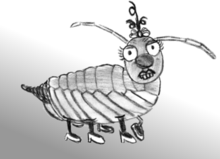Stone louse

The stone louse (Petrophaga lorioti, in German Steinlaus) is a fictitious animal created by German humorist Loriot to parody nature documentaries. It was primarily featured in a video sketch, as well as being a fictitious entry in the German medical encyclopedic dictionary Pschyrembel Klinisches Wörterbuch.
Characteristics
Its 1976 "discovery" by Loriot parodied the presentation style of "Ein Platz für Tiere" ("A Place for Animals", a longstanding TV series about endangered wildlife) by the famous German zoologist and documentary filmmaker Dr. Bernhard Grzimek (ARD, 20.47-51).
In a factual style, the stone louse was described as a rodent-like mite in the order "Fictional Rodents", between 20 and 24 mm in length which consumes about 28 kilograms of stone per day, depending on the density and tastiness of said stone. Loriot gave some deadpan comments on a filmed Building implosion, he mentioned the "shy rodent" to be at lunch in its natural habitat (before the explosion). While the building vanished into dust and rubble he caringly spoke about the "possierliche kleine Nager" (endearing little rodents) and concluded with some points about their endangered status.

Publication in Pschyrembel
In 1983 the clinical dictionary Pschyrembel, from German scientific publisher Walter de Gruyter, contained information about the stone louse for the first time in printed form. The short article is thought[citation needed] to be based mainly on Loriot's TV documentary.
Extending Loriot's parody, the Pschyrembel informs about the louse's "value" in fighting bladder, gall and kidney stones. The subspecies gallstone louse and kidney stone louse are mentioned only briefly due to "lack of further scientific data".
In the 257th edition of the Pschyrembel, the authors omitted the fictitious entry. The following edition, in 1997, featured it again due to protests from readers and was presented on Frankfurt Book Fair as the correct "Steinlaus inside" version.
Recently found "insights" found their way into this new version, which even speculated about the stone louse's participation in the fall of the Berlin Wall, since the wall was mainly placed in areas "commonly inhabited by the stone louse". That theory was reinforced by "discoveries" that the stone louse might have been used by the Spartans to bring down the ancient Athenians' Long Walls. Other hypotheses connect the stone louse with the end of the Stone Age.
The Pschyrembel denies that the stone louse has become extinct, and refers to recent "sightings" by a local expert on stone lice, "Dr. Schlereth", at construction sites in Kronach, Bavaria. The 260th and (as of 2007) most recent edition extends the article even further, referring to results in homeopathy.
Further publications and sightings
The fictional Member of Parliament Jakob Maria Mierscheid has contributed to the (fictional) 3. Hoechster Steinlaus-Symposium, XII (3) in Frankfurt.[1]
A contribution to a Senckenberg Museum Symposium in Frankfurt 1999 mentioned "dangers" posed by stone lice to the protection of architectural heritage and monuments.[2]
Within Dortmund Zoo some stone lice are "tended" and "on display".
According a scientific paper of Deutsche Bibliothek a ballpark guess of the amount of stone lice in the neighborhood of German libraries amounted to 113.3 billion. The author, Dr. Florian Seiffert, assumes that after the fall of the Berlin Wall, stone lice went for another ecological niche and found it in libraries.[3]
The German Insurance Catalogue for the German Public Health Service (only the G-DRG Version 2003/2004) temporarily mentioned Stonelouse Parasitism on men as a possible illness and gave some indications about average treatment, cost tags and remedies. The Color Atlas of Pathology by Thieme Medical Publishers refers to Petrophaga lorioti as a therapeutic infestation that could be used in the management of stone disorders.
The municipality of Zürich has issued an official guidance for citizens having trouble with stone lice.[4]
References
- ↑ Jakob Maria Mierscheid Ökologische Kenndaten zum FCKW- Ersatzstoff R 134a, 3. Hoechster Steinlaus-Symposium, XII (3), Frankfurt/M., 1993 (Ecological Data of FCKW substitutes)
- ↑ Dr. Wolfgang E. Krumbein Leben am Rande des Möglichen (Life on the edge of possibility), Senckenberg Museum Symposium in Frankfurt 1999
- ↑ Untersuchung über die Verbreitung der Steinlaus in wissenschaftlichen Bibliotheken in Deutschland. Eine Erhebung im Rahmen der Deutschen Bibliotheksstatistik 20021. By Dr. Florian Seiffert, Steinlauszentrum des Landes Nordrhein-Westfalen, Marsiliusstr. 65, 50937 Köln / 13. März 2004, Statistical Enquiry of Deutsche Bibliothek
- ↑ Merkblatt der Stadt Zürich zu Steinlausbefall (Recommondations of the City of Zürich concerning Stone Louse Parasitism)
External links
- German newspaper report about "real" sightings at the Stephansdom, Austria.
- Pschyrembel official Stone Louse Blog (in German, including all versions of the entry and various further research)